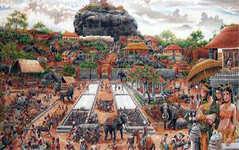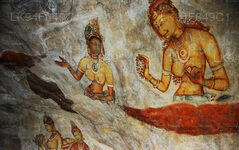
アヌラーダプラの宿泊施設
아누라다푸라는 스리랑카 북중부 지방에 속합니다. 아누라다푸라는 스리랑카의 고대 수도 중 하나로, 잘 보존된 고대 스리랑카 문명 유적지로 유명합니다. 현재 유네스코 세계문화유산으로 지정된 이 도시는 스리랑카의 현재 수도 콜롬보에서 북쪽으로 205km 떨어져 있습니다.
King Kashyapa I of Anuradhapura
The citadel of Sigiriya is, possibly, the most famous historical icon of Sri Lanka. Created on an almost sheer rock rising from the plains of Anuradhapura; the citadel is a marvel of ancient architecture. But the most important and mysterious aspect of Sigiriya are its unfading rock frescoes. These beautiful paintings have not lost their color in over a thousand years and have been the marvel of archaeologists and researchers from around the world. Despite this, the story of the king who created and ruled this citadel is not very well known.
The beginnings of King Kashyapa
Kashyapa I, or Kassapa I as he is also known, was born as the eldest son of King Dhatusena in the middle of the 5th century AD. He was talented in politics, war strategies and the arts as a prince ought to be; but luck was not on his side. Despite being born the eldest he was the son from one of the king’s concubines; and his younger stepbrother who was the son of the royal consort was declared the rightful heir. Kashyapa felt that the crown prince Mogallana was a coward and not fit for the throne. He resented the fact that he had been ignored.
A plan is hatched
Meanwhile, Kashyapa’s father – king Dhatusena had an army commander, whose name was Migara. This commander had a disagreement with the king and sought to have vengeance for it. Migara was cunning, and knew Prince Kashyapa’s feelings on not being nominated the heir. He incited the prince to rebel against his father.
Assisted and encouraged by Migara, Kashyapa staged a palace coup. He overthrew King Dhatusena and usurped the throne 473 AD. The former king was imprisoned, while Kashyapa I became the second king of the Mouriyan Dynasty of Sri Lanka. The crown prince Mogallana appeared to prove Kashyapa’s judgement of being a coward true, as he fled to India to save his own life. Kashyapa’s rule may have proved comparatively normal; if not for the deceitful Migara. The commander was not satisfied with the king being simply overthrown; he wanted him dead.
A loss of temper and the results of bad decisions
Migara made Kashyapa to believe that the former king Dhatusena had hid an enormous amount of wealth and the misled prince demanded that the imprisoned king reveal all his treasures. The king looked at him sadly and then led him to Kalawewa, an irrigation tank that he had constructed. ‘This is the only treasure I have’ he said to his captors. Kashyapa, blinded by his greed and pride, became incensed by this response and ordered him entombed alive within the wall of the irrigation tank – or so the story goes. Another version of the tale states that Kashyapa had Dhatusena killed and walled up the body within a random wall.
This cruel decision of his earned him the enmity of public and the priests. They called him Pithru Gathaka Kashyapa (Patricidal Kashyapa) and spewed vitriol at him. Fearing rebel action from either the people or his step-brother Mogallana; King Kashyapa sought a more secure location for his citadel.
Sigiriya is born
Kashyapa discovered a large, roughly lion-shaped rock that rose almost vertically out of the plains of Anuradhapura. He had a large citadel and an elaborate city built on the sides of the rock. His palace was constructed on the top of the rock. He had the lion-like protruberances carved more elaborately; and named the rock ‘Sigiriya’ or ‘Lion Hill’.
Sigiriya depicted the king’s taste for an artistic and luxurious lifestyle. There were large beautiful gardens with a number of pools, fountains and other structures; a complex underground irrigation system that supplied water to the pools and fountains; the famous Mirror Wall which was shiny enough to see one’s face in its heyday; and wonderful frescoes of heavenly maidens carrying flowers.
Despite its comforts, Sigiriya had enhanced defense allowing unhindered views of the nearby plains. There were large rampart and moats built around the city protecting it. Sigiriya lived up to its name as the new capital with its strategic advantage for the defenders during an attack.
The Fall of Kashyapa
Though King Kashyapa did his best to protect his kingdom; his efforts proved in vain. In 495 AD, over twenty years after the beginning of his reign, Kashyapa’s stepbrother Mogallana invaded with an army from South India in order to claim his throne. A fierce battle ensued on the plains of Anuradhapura; and Kashyapa, with his lack of support amongst his own people, was overwhelmed by the foreign forces and lost. He did not lose his pride though, and not wishing to be captured and tortured; King Kashyapa I fell on his own sword and killed himself. Kashyapa’s stepbrother Mogallana was enthroned after him and became King Mogallana I.
아누라다푸라 지구 소개
아누라다푸라는 스리랑카 북중부 지방에 속합니다. 아누라다푸라는 스리랑카의 고대 수도 중 하나로, 잘 보존된 고대 스리랑카 문명 유적지로 유명합니다. 현재 유네스코 세계문화유산으로 지정된 이 도시는 스리랑카의 현재 수도 콜롬보에서 북쪽으로 205km 떨어져 있습니다. 신성한 도시 아누라다푸라와 그 주변에는 수많은 유적이 있습니다. 유적은 다고바, 수도원, 그리고 포쿠나(연못)의 세 가지 유형의 건물로 구성되어 있습니다. 이 도시는 고대 세계에서 가장 복잡한 관개 시스템을 갖추고 있었으며, 국가의 건조 지대에 위치해 행정부는 토지에 관개를 위해 많은 탱크를 건설했습니다. 대부분의 민간인은 싱할라족이며, 타밀족과 스리랑카 무어족이 이 지역에 거주합니다.
북중부 지방 소개
북중부 지방은 이 나라에서 가장 큰 지방으로 전체 국가 면적의 16%를 차지했습니다. 북중부 지방은 폴로나루와와 아누라다푸레라는 두 개의 지구로 구성되어 있습니다. 아누라다푸라는 스리랑카에서 가장 큰 지구입니다. 면적은 7,128km²입니다. 북중부 지방은 투자자들이 사업을 시작할 수 있는 수많은 잠재력을 가지고 있으며, 특히 농업, 농업 기반 산업 및 축산 분야가 그렇습니다. 북중부 지방 주민의 65% 이상이 기초 농업 및 농업 기반 산업에 의존합니다. NCP는 이 지방에 중대형 탱크가 3,000개 이상 있기 때문에 "웨우 벤디 라제"라고도 불립니다. 스리 마하 보디야, 루완웰리 세야, 투파라마 다게바, 아바야기리 수도원, 폴로나루와 랑코트 웨헤라, 란카티레이크가 두렵습니다.














